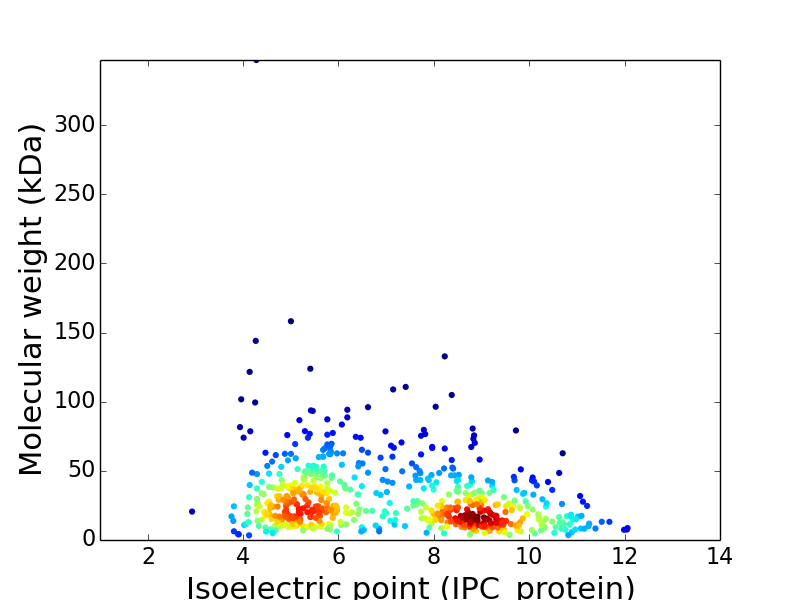
candidate division WWE3 bacterium CSP1-7
Taxonomy: cellular organisms; Bacteria; unclassified Bacteria; Bacteria candidate phyla; candidate division WWE3
Average proteome isoelectric point is 7.18
Get precalculated fractions of proteins

Virtual 2D-PAGE plot for 622 proteins (isoelectric point calculated using IPC_method)
Get csv file with sequences according given criteria:
* You can choose from 18 different methods for calculating isoelectric point
Protein with the lowest isoelectric point:
>tr|A0A0T5ZX92|A0A0T5ZX92_9BACT Thrombospondin type 3 repeat family protein
MNMRKFLSFLVIALVFGLGGYFASKYLPVGTVFADNDNDGITDDVDADDDNDGILDTEDVDAQEDHSLDHDNDGTDDSEDLDDDNDGIEDEQDDSDLDEDNDGVDDGDDVDDDNDDKVDTEENQFEDDLDEDGQDNEIDQDDDNDGTLDSEDSDDDNDEVEDAEDPDDDGDEVEDAEEEIEDHGGE
MNMRKFLSFLVIALVFGLGGYFASKYLPVGTVFADNDNDGITDDVDADDDNDGILDTEDVDAQEDHSLDHDNDGTDDSEDLDDDNDGIEDEQDDSDLDEDNDGVDDGDDVDDDNDDKVDTEENQFEDDLDEDGQDNEIDQDDDNDGTLDSEDSDDDNDEVEDAEDPDDDGDEVEDAEEEIEDHGGE
Molecular weight: 20.55 kDa
Isoelectric point according different methods:
Isoelectric point according different methods:
Protein with the highest isoelectric point:
>tr|A0A0T5ZXP5|A0A0T5ZXP5_9BACT 50S ribosomal protein L27 large subunit ribosomal protein L27
MAHKKAGGSKARQKPRVSGKRLGVKVGSGQKVPAGSIIIRQRGRNVAPGRGAGIGRDFTIFANKEGKVSFSTKQGKKHVSVN
MAHKKAGGSKARQKPRVSGKRLGVKVGSGQKVPAGSIIIRQRGRNVAPGRGAGIGRDFTIFANKEGKVSFSTKQGKKHVSVN
Molecular weight: 8.62 kDa
Isoelectric point according different methods:
Isoelectric point according different methods:
General Statistics
Number of major isoforms |
Number of additional isoforms |
Number of all proteins |
Number of amino acids |
Min. Seq. Length |
Max. Seq. Length |
Avg. Seq. Length |
Avg. Mol. Weight |
|---|---|---|---|---|---|---|---|
171,418 |
31 |
3,414 |
283.8 |
31.4 kDa |
Amino acid frequency
Ala |
Cys |
Asp |
Glu |
Phe |
Gly |
His |
Ile |
Lys |
Leu |
Met |
Asn |
Gln |
Pro |
Arg |
Ser |
Thr |
Val |
Trp |
Tyr |
|---|---|---|---|---|---|---|---|---|---|---|---|---|---|---|---|---|---|---|---|
8.44 |
0.63 |
4.86 |
6.97 |
4.6 |
8.12 |
1.52 |
6.12 |
5.83 |
10.46 |
1.66 |
3.34 |
3.11 |
4.75 |
5.76 |
6.34 |
5.64 |
7.62 |
1.31 |
2.92 |
For dipeptide frequency statistics click here
Proteome-pI is available under Creative Commons Attribution-NoDerivs license, for more details see here
| Reference: Kozlowski LP. Proteome-pI: proteome isoelectric point database. Nucleic Acids Res. 2016. doi: 10.1093/nar/gkw978 |
Contact: Lukasz P. Kozlowski |

